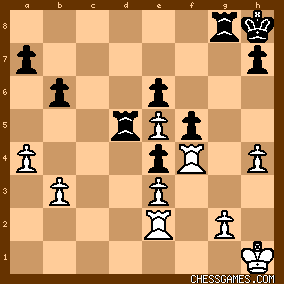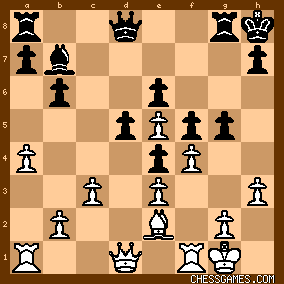|
< Earlier Kibitzing · PAGE 2 OF 2 ·
Later Kibitzing> |
| Sep-16-05 | | azaris: <White can instead play 33. cxd5! ♖h3+ 34. ♔g1 ♕g3 35. ♖ef2, when there is no mate in view - a flaw at the end of Alekhine's brilliancy> |
|
| Aug-15-06 | | Sleeping kitten: That is very strange, I have books which give the "supplement" moves 28...Rc7 29 Rc2 Rcg7 30 Te2. Le Lionnais's book or A.A.Alekhine's 200 chess games. However, Sylvester tells us his book don't give these moves. They are more likely to have been removed (for aesthetic concision) than added, I think. |
|
| Aug-16-06 | | Calli: Skinner and Verhoeven give the game as 33 moves. They cite SHAKHMATY 1926, p116-117 which is the earliest publication they found. Later Aljechin published the 35 move version in "Auf dem Wege ..." and then still later in French in "200 games..". So perhaps Aljechin knew better or maybe he just remembered it wrong. |
|
| Aug-16-06 | | Albertan: My chessbase database has the game finishing after 35 moves: Event "Dresden"]
[Site "Dresden"]
[Date "1926.??.??"]
[Round "6"]
[White "Rubinstein, Akiba"]
[Black "Alekhine, Alexander"]
[Result "0-1"]
[ECO "A46"]
[PlyCount "70"]
[EventDate "1926.??.??"]
[EventType "tourn"]
[EventRounds "9"]
[EventCountry "GER"]
[Source "ChessBase"]
1.d4 Nf6 2.Nf3 e6 3.Bf4 b6 4.h3 Bb7
5.Nbd2 Bd6 6.Bxd6 cxd6 7.e3 O-O
8.Be2 d5 9.O-O Nc6 10.c3 Ne4
11.Nxe4 dxe4 12.Nd2 f5 13.f4 g5
14.Nc4 d5 15.Ne5 Nxe5 16.dxe5 Kh8
17.a4 Rg8 18.Qd2 gxf4 19.Rxf4 Qg5
20.Bf1 Qg3 21.Kh1 Qg7 22.Qd4 Ba6
23.Rf2 Qg3 24.Rc2 Bxf1 25.Rxf1 Rac8
26.b3 Rc7 27.Re2 Rcg7 28.Rf4 Rc7
29.Rc2 Rcg7 30.Re2 Rg6 31.Qb4 Rh6
32.h4 Qg7 33.c4 Rg6 34.Qd2 Rg3
35.Qe1 Rxg2 0-1
|
|
| Aug-29-06 | | Resignation Trap: <azaris and drunkenknight> are right. Rubinstein's 35.Qe1?? loses the farm to the simple 35...Rxg2. Alekhine states that 34...Rg3 threatens 35...Rh3+ 36.Kg1 Qg3, "etc.", but 35.cxd5! Rh3+ 36.Kg1 Qg3 37.Ref2! and there's no earth-shattering kaboom. |
|
| Dec-11-06 | | micartouse: Alekhine's 5 ... Bd6!? is quite a courageous move that is worth keeping in mind. He's willing to mess up his pawn structure in order to weaken the kingside dark squares created after 4. h3?!. In fact, g3 becomes the primary target of the subsequent battle. This game is similar in a sense to Alekhine vs Rubinstein, 1921 in which Alekhine adopts extreme measures in order to refute unorthodox opening play. The cross-like pawn formation that occurs from move 19 to the end creates an aesthetic impression. |
|
Mar-17-07
 | | beatgiant: <Resignation Trap>
<Alekhine states that 34...Rg3 threatens 35...Rh3+ 36.Kg1 Qg3, "etc.", but 35.cxd5! Rh3+ 36.Kg1 Qg3 37.Ref2! and there's no earth-shattering kaboom.><note, assuming 35-move version in this discussion> I think you're right. I also looked at 35. cxd5 exd5 37. Rxf5? Rh3+ 38. Kg1 Qg3 39. Ref2 Qxh4, but white can reply 37. e6 instead and I didn't find any kaboom in that case either. So after 35. cxd5, Black probably replies 35...Rd8 and eventually picks up the e5 pawn. It makes me wonder whether 34...Rg3 was really the best here. If all he's going to do is win the e-pawn, why not the much simpler 34...Qxe5 immediately? Or better yet, first 34...dxc4 35. bxc4 Qxe5 leaves Black a pawn up with a much better position. |
|
| Jun-13-07 | | bramdas: According to Vukovic in "Art of Attack", the final move of this game (on page 189) is ..Rxg2 (not xe3). Black seems to win anyway, but thought i'd share this. |
|
| Jun-12-09 | | Bridgeburner: <<beatgiant> It makes me wonder whether 34...Rg3 was really the best here. If all he's going to do is win the e-pawn, why not the much simpler 34...Qxe5 immediately? Or better yet, first 34...dxc4 35. bxc4 Qxe5 leaves Black a pawn up with a much better position.> Right on all counts (apart from the move numbering). After <32...Rg3>, then <33.cxd5> certainly prolongs the resistance. After <33...Rd8 34.Qc1 Rxd5 35.Qc8+ Qg8 36.Qxg8+ Rxg8>: 
click for larger viewthe rooks and pawns ending is probably still won for Black, but not without effort. White's pawn structure is difficult to defend and would probably be his downfall in such an ending. Rubinstein's losing move probably occurs in the position following Black's <17...Rg8>: 
click for larger viewHere <18.Qd2?> takes the eye off the ball. Necessary and vitally important was to defend the approaches to the King with <18.Kh2!>. If <18...gxf4> then White can happily recapture with <19.exf4> as <19...Qh4> loses the deadly impact it has in the game. White now has <20.Qe1> completely neutralizing Black's attack as the pawn on <h3> is now fully defended. Rubinstein was IMO completely psyched out and consequently hopelessly outclassed in this game after his recent and devastating losses to Alekhine. |
|
| May-26-12 | | computer chess guy: Engines prefer 29. .. ♕e1+! 30. ♔h2 ♖g3, and White seems to be unable to avoid a lost endgame. For example 31. ♕d2 ♖xe3 32. ♕xe1 ♖xe1 33. ♔g3 d4 34. ♔f1 ♖h1 35. ♖e3 ♖xc3  . . |
|
| Aug-24-12 | | HaydenB: No one has mentioned Alekhines own comments to this game. This is my favorite Alekhine game.
He gains tempo after tempo making another world class GM look like an amateur. You all should get "Alekhines best games" and read his highly instructive and entertaining comments yourself. |
|
Aug-24-12
 | | beatgiant: <computer chess guy> What do the engines find after 29...Qe1+ 30. Rxe1? |
|
| Jun-26-15 | | SpiritedReposte: <Black Diamond> |
|
Sep-29-16
 | | tpstar: 33 ... Rxe3! is cute but White can play on with 34. Qf1 or 34. Rff2. After 33 ... Rxg2 then 34. Qf1 and 34. Rff2 both lose to 34 ... Rg1+ winning the Queen, so the final move being 33 ... Rxg2 is much more likely. Powerful major piece endgame by Alekhine. The position after 30. h4 is a Soltis puzzle from the November 2001 "Chess Life" (Dresden 1926) with the quiet move solution 30 ... Qg7! followed by tripling on the g file with 31 ... Rg6. |
|
Aug-17-17
 | | plang: 4 h3 was already a new move though after the clever 5..Bd6!? Black was already at least equal. 17 a4?! was too slow; 17 g3 followed by Kh2 was recommended as a better defense. The queen maneuver 20..Qg3, 21..Qg7 and 23..Qg3 is quite attractive. Great game by Alekhine from beginning to end. |
|
Sep-03-22
 | | kingscrusher: How to beat the dreaded London system by Alexander Alekhine |
|
| Jul-15-23 | | ndg2: This was one year before the Capa match. Alekhine over the years became like really, really strong, a clear 2nd behind the Cuban and this game shows. |
|
Jul-15-23
 | | perfidious: The curious thing about the year 1926 was that Alekhine finished second in both major events in which he participated, with Nimzowitsch having the performance of his life at Dresden, while Spielmann edged Alekhine at Semmering. |
|
Jul-15-23
 | | offramp: The pun is based on the humorous song "Brimful of Asha on the 45", by <Cornershop>. |
|
| Jul-15-23 | | goodevans: Nice game. Watching ...Rc8/...Rc7/...Rg7/...Rg6/...Rh6 was a bit like watching a car crash in slow motion. It felt like there was nothing White could do about it although many previous kibitzes suggest that there was. As for the final move, also the subject of many kibitzes, it seems unlikely that Alekhine would have passed up the obvious, simple and crushing 33...Rxg2 for the less clear 33...Rxe3. On the other hand, why would anyone invent that he played 33...Rxe3 so I'm at a loss on that one. As for the pun, I'm at a loss there too. Maybe <offramp> is telling the truth this time but that rascal can't always be trusted. I remember "Brimful of Asha..." and any connection is certainly not obvious to me. Will check back later for enlightenment, hopefully. |
|
Jul-15-23
 | | Teyss: <goodevans> The pun is a reference to "Lucy in the Sky with Diamonds", very stretched. The diamond is of course the Pe6-f5-e4-d5 formation, which makes the pun decent. Apparently Missy is listening to the Beatles' complete works this week. Naturally you know by now <offramp>'s posts are generally nonsensical. When they're not, they're half as interesting. I very much liked you slow crash metaphor. As usual (the metaphor, not the crash). |
|
Jul-15-23
 | | ketchuplover: fully loaded Alekhine's gun |
|
| Jul-15-23 | | goodevans: <Teyss> Thanks for the enlightenment. Your suggestion makes complete sense but I've repeated the pun several times, on one occasion with my mouth full of peanuts to see if that helped, but I still can't make it sound like the song title. |
|
Jul-15-23
 | | Teyss: <goodevans> The mouthful of peanuts is indeed a prerequisite but you're missing a few steps:
Beforehand, drink a full bottle of single malt (any spirit will do, it's just because you're a man of taste).
Imitate a Kazakh accent.
Voice the pun as fast as you can, repeatedly without pausing. After approx. the 150th instance, it will work. |
|
| Dec-06-24 | | Mathematicar: I was much more impressed by this game than by his flashy victory at Semmering. Rubinstein really wasn't at his peak in 1926, to say at least, but here Alekhine just squezed the life out of position and put a great master of endings in zugzwang. Much more impressive and integrative. |
|
 |
|
< Earlier Kibitzing · PAGE 2 OF 2 ·
Later Kibitzing> |





